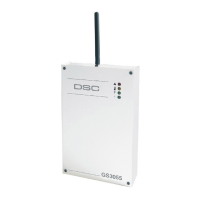
Do you have a question about the DSC GS3055-I and is the answer not in the manual?
| Brand | DSC |
|---|---|
| Model | GS3055-I |
| Category | Recording Equipment |
| Language | English |
Lists key capabilities like land line simulation, GSM network switching, SMS alerts, and Contact ID.
Details electrical and physical parameters like power supply, current draw, dimensions, and weight.
Identifies the main physical components of the GS3055-1 device.
Provides step-by-step instructions for physically installing the device, including mounting and cable entry.
Explains how to connect various terminals like Earth, External/Internal telephone line, and power supply.
Describes how the device simulates a land line, switching to GSM during line trouble.
Prioritizes engaging the line for the control panel's calls over ongoing communications.
Prioritizes sending SMS or Contact ID reports by interrupting ongoing GSM calls.
Ensures chronological sending of reports, prioritizing ContactID over SMS for simultaneous events.
Explains how OC outputs activate automatically based on predefined events like line trouble or calls.
Details controlling OC outputs manually via SMS or remote control numbers (BISTABLE/MONOSTABLE).
Describes how to activate/deactivate outputs that maintain their state until a command is received.
Explains how outputs activate for a set duration and then automatically deactivate.
Describes how to view the device's current configuration settings on the screen.
Explains the process of saving or updating device configuration data from a file.
Outlines initial steps for using the software, including customer management and data loading.
Details the phonebook settings, including number entry and remote control number selection.
Describes the main window interface for configuring SMS messages and input line special functions.
Configures output polarity, event activation, reserved outputs, labels, and feedback signals.
Defines a code for users to control outputs over the phone.
Allows configuration of Contact ID reporting, including events and codes.
Field to enter the GPRS service provider's Access Point Name for internet connectivity.
Specifies the IP address and port number of the central station receiver.
Fields for entering user credentials required by some GPRS providers for authentication.
Numbers to be recognized by the device for triggering GPRS communication.
Optional field to enter the GPRS SIM card number.
Optional field for Dialled Number Identification Service number.
Required code for communication with specific central station receivers.
Displays GSM module data, network provider, battery charge, and signal reception.
Shows the status of the 4 Inputs and any associated special functions.
Displays the status of the 4 Outputs and allows real-time activation/deactivation.
Records and displays the sequence of events as they occur.
Indicates the scheduled date and time for the next periodic SMS text message.
Indicates the scheduled date and time for the next periodic Contact ID report.
Allows interruption of ongoing calls and stopping the outgoing call queue.
Instructions on how to change the device's access code using an SMS text message.
Information on making calls over the GSM network when the device is connected to a telephone.
References to other sections for additional details on LEDs, operation, and remote programming.